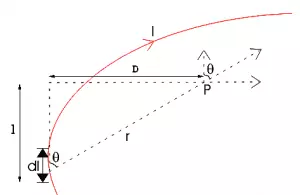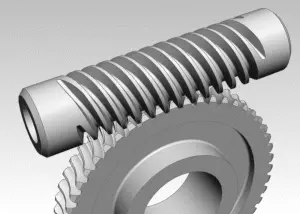Inside Story
POISEULLIE’S LAW: OVERVIEW
So today in today’s article, we are going to talk about a very important and interesting concept of hydrodynamics, that is poiseullie’s laws. So going further it is necessary to understand the underlying concept of poiseullie‘s laws in the very simplest form. In poiseullie’s laws, the fluid motion should be streamlined throughout the pipe.
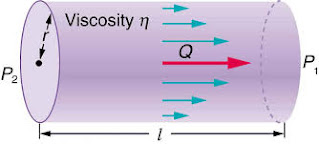
So let’s start
We are starting the concept with a question in what manner a viscous fluid flows through a cylindrical pipe? In any cylindrical pipe when viscous fluid flows then they follow a convex meniscus, but why? It is because we know that a streamlined fluid has several streams of fluid.
Then some streams are near the wall of the pipe and some stream is far from the wall, In the cylindrical pipe, the longest distance from the wall is to the center of the pipe. And we know that the pipe is cylindrical then the shape of water which is flowing through it, must be in the shape of a cylinder.
And this is not only for the cylindrical body, this laminar flow held in all types of the body in which fluid is flowing. This gives a convex form as given below.
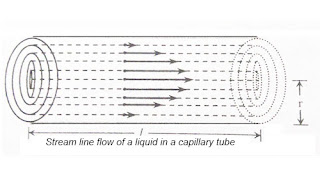
POISEULLIE’S LAW: BASICS
First of all, we have to know that poiseullie’s laws measure what? Poiseullie’s laws measure only the rate of flow of volume of fluid per second in the pipe. Going further let’s give a sight at what factors can volume rate depends on.
It is also a daily basis phenomenon, if any road is narrow then it suffers high traffic, but a broader road is free from traffic. The same is here. And third is flow rate is inversely proportional to the viscosity, larger viscosity larger friction then larger opposition and then smaller velocity than smaller flow rate. And fourth is it is inversely proportional to the length of the pipe, how? If length increases then the time of friction to the wall also increases, and friction increases then same as above.
So now we are going to derive a formula for the rate of flow of fluid volume per second.
DERIVATION FOR POISEULLIE’S FORMULA
Let’s take a cylinder of radius R and length L as shown below,
And flowing fluid of viscosity η, and dr is the small distance between two cylindrical laminae. For understanding see the diagram below.
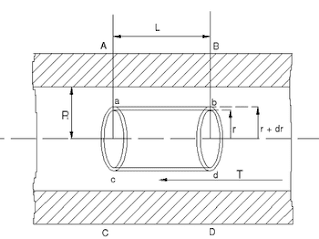
When a fluid is in the pipe then the force of viscosity generated due to the friction between the two lamina is given as below:[latexpage]
$$F = -\eta A\left(\frac{dv}{dr}\right)$$
Where A is the curved surface of the lamina with radius r and length L that is;
$$A = -2\pi rL$$
And $\frac{dv}{dr}$ is the velocity gradient, which means velocity changes with change in radius.
Here sign is negative because this force opposes the velocity of the fluid.
Then put all the values F become-
$$F= -2\pi\eta rL\left(\frac{dv}{dr}\right)$$
And we know that fluid is flowing through the pipe due to pressure difference-
$$P = P_1-P_2$$
This pressure can be expressed in external force per unit area, then force is given as;
$$F = P\pi r^2$$
In equilibrium condition, when external force became equal to the laminar frictional force that is viscous force. Equating both forces we get- Here we take only the magnitude
$$P\pi r^2 = 2\pi\eta rL\frac{dv}{dr}$$
After simplification we get-
$$\frac{dv}{dr} = \frac{Pr}{2\eta L}$$
Then, $$ dv =\left(\frac{Pr}{2\eta L}\right)dr$$. Now integrating both sides from r to R, we get
$$\int dv = \frac{P}{2\eta L}\int_r^ R {rdr}$$
On solving we get-
$$v = \left[\frac{P}{4\eta L}\right]\left(R^2-r^2\right)$$
Now applying the equation of continuity, we get $V = A_1v_1=A_2v_2$, Where V is volume.
Then for a small cross-sectional area dA, we get a small volume of fluid that is dV
$$dV = dA\times v$$ Putting all values, we get-
$$dV = 2\pi rdr\times P\left(\frac{R^2-r^2}{4\eta L}\right)$$
On solving we get-
$$dV = \frac{P\pi\left(r.R^2-r^3\right)}{2\eta L}dr$$
Again integrating both sides from 0 to R because we want to find the whole volume of fluid in the pipe. Then we get-
$$\int{dV} = \frac{P\pi}{2\eta L}\int_0^ R\left[r.R^2-r^3\right]dr$$
On solving we get-
$$\begin{align*}V& = \frac{P\pi}{2\eta L}\left[\frac{\left(R^2.R^2\right)}{2}-\frac{R^4}{4}\right]\\
V&= \frac{P\pi}{2\eta L}\left[\frac{R^4}{2} – \frac{R^4}{4}\right]\end{align*}$$
On solving we get
$$V = \frac{P\pi R^4}{8\eta L}$$
This is the fluid that is flowing per second through the pipe. Watch this video for more reference.

